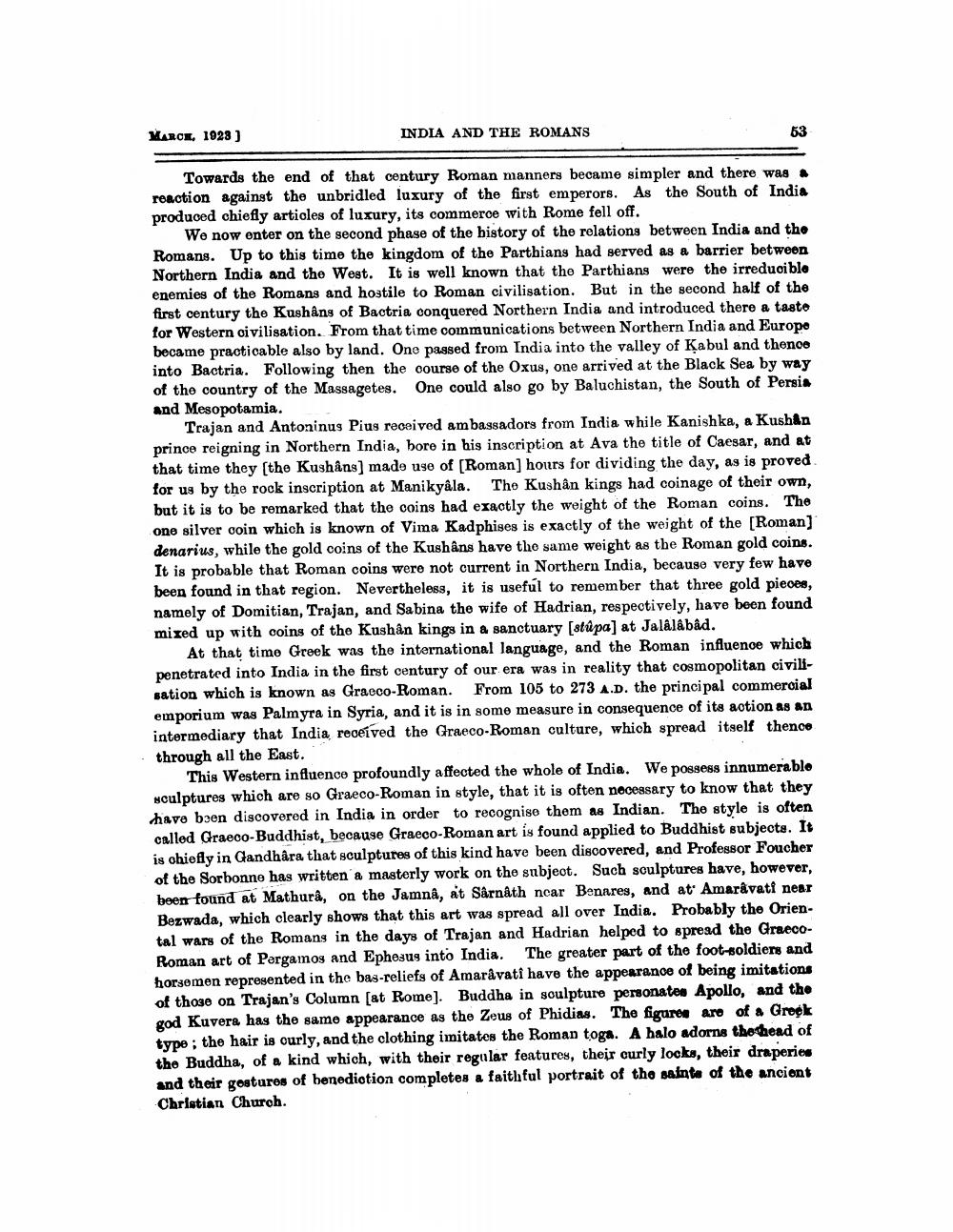________________
MARCE, 1028 )
INDIA AND THE ROMANS
53
Towards the end of that century Roman manners became simpler and there was reaction against the unbridled luxury of the first emperors. As the South of India produced chiefly articles of luxury, its commerce with Rome fell off.
We now enter on the second phase of the bistory of the relations between India and the Romans. Up to this time the kingdom of the Parthians had served as a barrier between Northern India and the West. It is well known that the Parthians were the irreduci blo enemies of the Romans and hostile to Roman civilisation. But in the second half of the first century the Kushåns of Bactria conquered Northern India and introduced there a taste for Western civilisation. From that time communications between Northern India and Europe became practicable also by land. One passed from India into the valley of Kabul and thenoo into Bactria. Following then the course of the Oxus, one arrived at the Black Sea by way of the country of the Massagetes. One could also go by Baluchistan, the South of Persia and Mesopotamia.
Trajan and Antoninus Pius received ambassadors from India while Kanishka, a Kushan prince reigning in Northern India, bore in his inscription at Ava the title of Caesar, and at that time they (the Kushåns) made use of (Roman) hours for dividing the day, as is proved for us by the rock inscription at Manikyala. The Kushân kings had coinage of their own, but it is to be remarked that the coins had exactly the weight of the Roman coins. The one silver coin which is known of Vima Kadphises is exactly of the weight of the (Roman) denarius, while the gold coins of the Kushans have the same weight as the Roman gold coins. It is probable that Roman coins were not current in Northern India, because very few have been found in that region. Nevertheless, it is useful to remember that three gold pieces, namely of Domitian, Trajan, and Sabina the wife of Hadrian, respectively, have been found mixed up with coins of the Kushån kings in a sanctuary [stúpa] at Jalalabad.
At that time Greek was the international language, and the Roman influence which penetrated into India in the first century of our era was in reality that cosmopolitan civilisation which is known as Graoco-Roman. From 105 to 273 A.D. the principal commercial emporium was Palmyra in Syria, and it is in some measure in consequence of its action as an intermediary that India received the Graeco-Roman culture, which spread itself thence through all the East.
This Western influence profoundly affected the whole of India. We possess innumerablo sculptures which are so Graeco-Roman in style, that it is often necessary to know that they have buen discovered in India in order to recognise them as Indian. The style is often called Graeco-Buddhist, because Graeco-Roman art is found applied to Buddhist subjects. It is chiefly in Gandhâra that sculptures of this kind have been discovered, and Professor Foucher of the Sorbonne has written a masterly work on the subjeot. Such soulptures have, however, been found at Mathurâ, on the Jamna, at Sårnáth near Benares, and at Amaravati near Bezwada, which clearly shows that this art was spread all over India. Probably the Oriental wars of the Romans in the days of Trajan and Hadrian helped to spread the GraecoRoman art of Pergamos and Ephesus into India. The greater part of the foot-soldiers and horsemen represented in the bas-reliefs of Amaravati have the appearance of being imitations of those on Trajan's Column (at Rome). Buddha in sculpture personates Apollo, and the god Kuvera has the same appearance as the Zeus of Phidias. The figures are of a Grock type; the hair is ourly, and the clothing imitates the Roman toga. A halo adorna thothead of the Buddha, of a kind which, with their regular features, their curly locks, their draperies and their gostures of benediction completes a faithful portrait of the saints of the ancient Christian Church.




